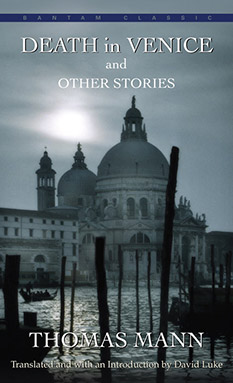
Historically, Thomas Mann’s 1912 novella has been read either as a quasi confessional reflection on male (homo)sexuality, or as a reflection on beauty and the author’s responsibilities. Gustav von Aschenbach, an established writer of some renown, widowed with an adult daughter, decides that he would benefit from an extended holiday. After a false start, he settles himself in Venice but is inclined to shove off once again; the weather is unsettled, the sky is dull, and a questionable air blows in from the sea. He is, however, drawn to a youth of perhaps 15 who carries himself with an exquisite beauty that sees the Mann/Aschenbach narrator tearing off on rapturous rhapsodic riffs that consume him for the rest of the novella:
With astonishment Aschenbach noticed that the boy was entirely beautiful. His countenance, pale and gracefully reserved, was surrounded by ringlets of honey-colored hair, and with its straight nose, its enchanting mouth, its expression of sweet and divine gravity, it recalled Greek sculpture of the noblest period; yet despite the purest formal perfection, it had such unique personal charm that he who now contemplated it felt he had never beheld, in nature or in art, anything so consummately successful.
In his obsession, he begins to treat the boy not as a boy but as an abstraction:
His eyes embraced that noble figure at the blue water’s edge, and in rising ecstasy he felt he was gazing on Beauty itself, on Form as a thought of God, on the one and pure perfection which dwells in the spirit and of which a human image and likeness had here been lightly and graciously set up for him to worship.
As Ashenbach is preparing to leave, the hotel misroutes his luggage and he uses the mistake as an excuse to remain, watching the boy as he passes his mornings on the beach, watching the boy with his family at meals, following the boy through the streets of Venice when the family goes on little excursions. The great writer frames his observations with what might best be described as meta-commentary. Things like this:
The fruit of solitude is originality, something daringly and disconcertingly beautiful, the poetic creation. But the fruit of solitude can also be the perverse, the disproportionate, the absurd and the forbidden.
And this:
Inborn in almost every artistic nature is a luxuriant, treacherous bias in favor of the injustice that creates beauty, a tendency to sympathize with aristocratic preference and pay it homage.
Reading these passages more than a century later, it’s hard to know how to respond. Our world has drifted into a ironic self-reflexive post-modern sensibility that finds it difficult to accept that Mann is being straight with us about Aschenbach’s proclivities. Then again, Mann was 37 at the time of the novella’s publication, a serious man, conservative by nature and by upbringing, who probably thought very much as Aschenbach did both on matters of letters and sexuality. Now, we read these passages with a nod and wink and tell the narrator to get over himself, but read on its own terms, that might be asking too much of the text.
We might also read Death in Venice as a plague novella and, here, I definitely ask too much of the text. Approaching the novella while in the midst of global pandemic, I am inclined to give matters of plague and illness a literal gloss, forgetting that as far back as Herodotus and Sophocles, we have also treated these matters as metaphor. But like so many others today, I have become something of an amateur epidemiologist and approach any mention of disease accordingly, so when Aschenbach arrives in Venice and cannot debark for an hour because the local public health inspector is delayed, I immediately take note. Two years of Covid-19 has put me on the alert and I can’t help but find plague at every turn.
Aschenbach nurtures his obsession and we soon forget about the public health inspector despite the occasional mention of the sirocco, a foul air that blows in from the sea and brings with it all sorts of vague complaints. We forget about him, that is, until rumours start to circulate about an illness. As quickly as Aschenbach learns some news, its source vanishes. He reads in a German language newspaper about a death, but later can’t find any German language papers; the hotel has discreetly disposed of them all. If word got out about a spreading illness, tourism in Venice would dry up and nobody would be able to make a living. How little things change. Even so, people talk, and Aschenbach soon learns that a cholera epidemic has been working its way into Europe from the Far East and has arrived by boat in Venice.
While many tourists have fled the city, Aschenbach is unwilling to leave so long as the object of his desire remains in the hotel. Even a fleeting glimpse of such beauty is worth the risk. Given the title of the novella, I don’t think it gives anything away to advise that Aschenbach succumbs while sitting on the nearly empty beach and watching the boy fight with his friend. We are left to wonder whether Aschenbach was correct when he observed “that language can only praise sensuous beauty, but not reproduce it.” It is now generally accepted that Mann transcended the restrictive view of his author/character. Following Mann’s lead, we may have to transcend the restrictive view of Covid-19 as a set of epidemiological facts and accept that it also carries with it meanings that bear a metaphorical or spiritual or ontological weight. In time, we may even learn to leverage our contemporary experience to aesthetic effect.
Death in Venice, by Thomas Mann, Introduction and Translation by David Luke (New York: Bantam, 1988)